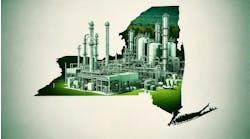Implementation isn’t the final action in energy management. With gradually rising energy costs, efficiency becomes a moving scale. When the scale shifts, the energy management cycle repeats again with new concepts and new technologies. So, in a continuously running plant there’s no end for energy efficiency measures; they only reach a new level in the efficiency scale.
[pullquote]
An interesting example explains this cycle: No traveler can miss the yellowish mountains around Johannesburg, the city of gold mines in South Africa. When the price of gold was $300/ounce, extracting gold at levels below 7 g from a ton of mined rock was uneconomical, and so several yellowish mountains grew. But today, when gold’s market price is over $1,500/ounce, the once-dumped mine rocks are fenced and protected for additional extraction in the future. So, an energy-savings opportunity ignored in the past could suddenly become a hot favorite to top management. Because energy management is a continuous improvement process, monitoring after implementation is a very essential step plant engineers shouldn’t ignore.
Many plants don’t pay much attention to energy management projects once implemented unless something goes wrong. Such a situation rarely happens; so managers are satisfied with a one-time performance assessment of the implemented project. However, post-implementation monitoring can help:
1. Confirm a good, sustained performance that gives the plant operating personnel and energy engineer confidence to explore other processes for possible energy savings. This also can motivate other plant personnel who were hesitant to improve energy cost savings.
2. Verify that problematic issues are corrected. A below-par performance would force the plant personnel, energy engineer and the vendor (if involved) to find out what went wrong and apply the necessary corrective measures.
3. Indicate performance variations due to changes in processing conditions and the seasons. Once the performance variation is correlated with these changes, optimization will be much easier.
4. Establish the financial performance of the energy project. Only then would the energy engineer’s credibility and requests for future funding be seriously considered.
The energy engineer who initiated the project, the manager who approved the funds and the operating personnel should be interested in post-implementation monitoring. Hence, it’s necessary to define the monitoring methodology as well as the project scope. Sometimes the existing metering system may suffice; occasionally, additional metering provisions may be required.
In one refinery’s successful energy management project, the first step was to restart the Energy & Loss Index calculations and report these data to management monthly. The results were phenomenal and were sustained month after month with only marginal improvements. No big capital investments were made in the first year, but the monthly monitoring led to more saleable fuels released to the market.
Current information technology provides several options for improved monitoring through data collection, data analysis and better reporting formats. Industries differ in their energy-performance-monitoring methodologies. Thus, it’s essential for an energy engineer to be aware of improvement processes in other industries. Whatever the method, internal or external experts should review data periodically to enable global comparison and to include technological developments.
The most common key performance indicators (KPIs) relate to consumption of a specific fuel or electricity per unit of output. Boiler efficiency is a globally comparable KPI, while Btu/lb of ammonia is specific to the plant. These KPIs also could be extended or modified to include different processing routes. In addition, it may be worth modifying older data processing methods with newer, faster methods that could generate energy-related KPIs directly, as well as correlate KPIs to cost. Vendors are a good source for learning about the latest technical developments.
When choosing the data processing method, it’s essential that it be capable of:
1. Acquiring data from the plant control database on a real-time basis.
2. Setting efficiency targets and evaluating the deviation between the actual and target.
3. Incorporating cost elements that are correlated from KPI.
4. Storing at least three years’ real-time data.
Though this column stresses monitoring energy cost as a post-implementation action, it shouldn’t be a first or last step, but a continuous action.
VEN V. VENKATESAN is Chemical Processing's Energy Columnist. You can e-mail him at [email protected]



